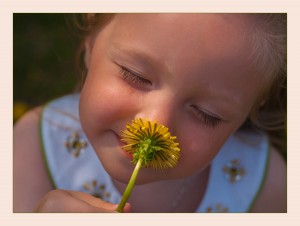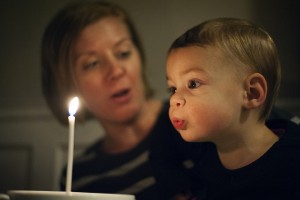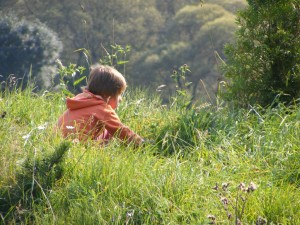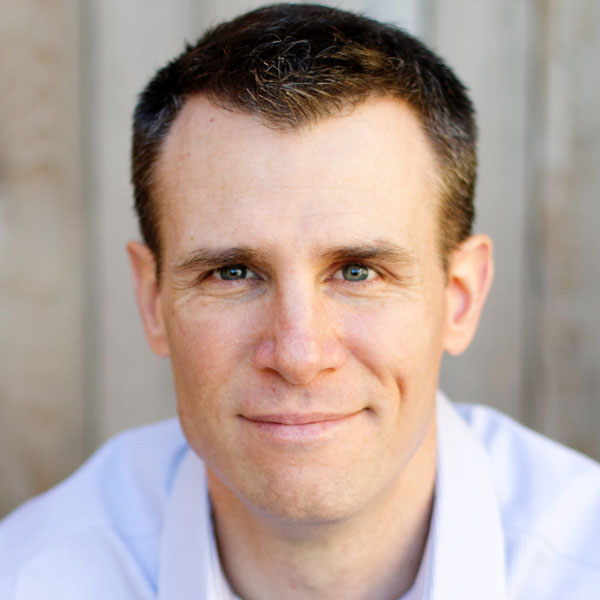Part 1 in a series on the neuroscience of surprise and the weight of wonder. This series explores how raising children up is really the work of growing adults down: grounding and embodying the Self in relationship, integrating the brain, and coming out of hiding.
The Splendid Splinter

My young daughter’s blonde head, bellowing with sunbeams fresh from the back porch, bobs its way through the kitchen door.
On this cool spring morning in Seattle, it’s hard to know which is more surprising: that the sun has conned its way through the forecasted gray clouds, or that Chloe is bouncing about like a jackrabbit.
“Dad, Dad! Help me!” she winces. Between hops, she is trying to catch both her breath and her tender foot.
“I have a splendor and it hurts!”
The wincing is now a wail.
“I have to get the splendor out!”
Never in my life have I tried to remove splendor from an appendage. (At my age, you’re trying to hang on to such things.)
But after considering together that this probably isn’t a case for a podiatrist or orthopedic surgeon – which takes some gentle Dad convincing – I carry Chloe upstairs to find the tweezers.
I set her on the bathroom counter. As this is her first ever splendor, she recoils at the sight of the little pincers being primed for the job.
Two bony arms quickly clasp around my neck. We pause together, to whisper solace and sanctuary.
Seconds later, we’re eyeing the hair-thin wisp of wood from our back deck. The sliver of splendor set free and now perched on the end of the tweezers.
“Wow,” Chloe murmurs.
Her body softens and soothes. Those crystal blue eyes begin pooling with a different sort of surprise: a moment of awe.
Then, seized by sudden delight, she grabs the tweezers and rushes the specimen downstairs.
“Mom! Mom, look!” she cries. “Look what Dad and I did!”
“Look at the splendor of my foot!”
A 6-year-old’s capacity to inhale life can be breath-taking.
They can live fully in this moment, and the next, in ways that might inspire vertigo in your average adult.
A 6-year-old’s pinging from terror to wonder, from wonder to awe, from awe to delight, may seem like a blur of terror-wonder-awe-delight – and yet often they are more experientially aware of their emotions, and their bodies, than adults.
Why is this? Well, neuro biologically, children are built closer to the ground.
The Brain and the Body-Mind
 Neuroscientist Daniel Siegel describes how the “upstairs brain,” which is under construction throughout childhood and into one’s mid-20s, eventually helps to manage the raw emotions and instincts of the “downstairs brain” with which we come into the world.
Neuroscientist Daniel Siegel describes how the “upstairs brain,” which is under construction throughout childhood and into one’s mid-20s, eventually helps to manage the raw emotions and instincts of the “downstairs brain” with which we come into the world.
In other words, the brain develops from the bottom-up.
The instinctual (reptilian) brain, located in the brain stem, controls basic bodily functions. It’s topped by the lower limbic (mammalian) system, or the emotion seat and alarm center of the brain, which primes a baby for social-emotional learning and attachment to caregivers.
Together, these first two layers form the “emotional brain” at the hub of the body’s central nervous system. The emotional brain alerts and moves you to respond to danger, safety and opportunity.
In our early years, the brain’s development follows a path that is both bottom-up (vertical) and right-left (horizontal).
Babies and children are “right-brain” dominant creatures. They interpret experiences through the brain’s right hemisphere, which processes information intuitively and holistically – through images, body sensations, movements, and feelings.
Our earliest pre-verbal memories, called implicit or procedural memories, are registered by the body and stored subconsciously in the right brain, which comes online while the baby is still in the womb. The “body-mind” retains these memories, and can deeply sense and “feel” them throughout adulthood in ways that our logical mind cannot access.
Essentially, the emotional/sensory right brain is more body-oriented.
The right prefrontal cortex is deeply connected with the subcortical limbic system and lower brain structures, and the body functions it works to regulate – everything from breathing to blinking.
The Whole Brain: Integrated Parts
Not until age 3 does the brain’s left hemisphere and its more “executive” function gain an upper hand in the developing neocortex, the top layer or “upstairs brain.” The more rational left-brain analyzes experience (and emotions) with language, linear thought, logic, and symbols.
Personal and relational health are optimized by a brain that can effectively “integrate” all of its parts – through right-left, top-down, and bottom-up processing.
But keep in mind: the right brain remains intricately wired with the body-mind throughout life.
As adults, we often lose touch with this grounding reality. Our brains need body-based rituals and practices to find it again. (More on this later in the series.)
Thinking About Feeling
In this sense, children are more “grown down.” They tend to be more connected to their emotions, their bodies, and the world around them.
Being “grown down” is a good thing. Being grounded in our bodies – mindfully observing our thoughts, feelings, and physical selves – ultimately opens us to childlike wonder, to awe, and to worship.
But yes, there are the tantrums. Those moments when the child’s churning downstairs brain, flooded with emotional-sensory experience and right-brain bias, “flips the lid” (in Siegel’s words) of the still-developing upstairs brain.
In other words, kids can get stuck “feeling about feelings.” Sometimes they need help slowing down and “thinking about feelings.” They need adults to serve as an artificial prefrontal cortex while they’re learning to find their own words, their own wisdom.
The ups and downs of relationships will stimulate the brain to develop vertically and horizontally and to “integrate” its different parts by utilizing them simultaneously.
The Stuck-Up Grownup
Adult tantrums are also lid-flipping. With more inner resources than a child, we can employ (if we choose) higher powers of reasoning to manage our impulses and emotions.
However, this higher adult functioning can fool people.
In other words, sometimes adult “reasoning” is mistaken for maturity. When used avoidantly, our task-modes and cognition can mask (and drive) a deeper, dis-integrating anxiety.
In anxious moments, adults are conditioned to “dissociate” – we protect ourselves by detaching from our core feelings and body sensations. The body-mind cringes, triggered by unconscious associations to unresolved hurts and shame from our past.
Cut off from our deeper emotions and our bodies, our thoughts begin spinning and ruminating. We like to say that “I’m losing my mind,” which really is short-hand for describing how our minds and bodies lose track of one another.
We get stuck or lost “up” in our heads. It’s part of being a “grown-up.”
Raising Children, Grounding Parents
Integration is a lifelong work. What changes as we age is the direction of integration.
Adults raise children “up” – helping to build their upstairs brains and expand their horizons.
Children also raise parents – by calling adults to “grow down.” The work of adult-ing is about re-rooting ourselves in our bodies, emotions, and underlying stories.
Attuning to ourselves as parents is what Siegel refers to as “parenting from the inside out.”
The most effective parent isn’t the behavior-focused parent who engineers well-mannered or successful children. Real parenting starts with recognizing and managing the hidden anxiety triggers in your own back-story, so you can stop projecting them onto loved ones. Learning to regulate and narrate your own emotional state allows you to raise children who are mindful, integrated and confident.
Parenting is as much about understanding yourself as it is your child.
Slowing, Sensing, Joining
 Left to its own devices, my grown-up self can become so controlled and compartmentalized – so splintered – that I risk missing the “splendor” ripening in the moment.
Left to its own devices, my grown-up self can become so controlled and compartmentalized – so splintered – that I risk missing the “splendor” ripening in the moment.
The morning my daughter bounded into the kitchen on one foot, I was stuck “up” in my head. I was preoccupied with making breakfast, scheduling the day, returning emails, and resolving a family matter.
I very nearly missed Chloe’s calling me into the present. Of course, she didn’t realize her “calling.” Children rarely do. They’re too busy living it.
Despite her physical pain, Chloe wasn’t the disembodied one – I was. Irritated by one more interruption, I had to resist flipping into fix-it mode. I had to get out of my head and down into my body, down into the grit of the moment.
In this moment, everything slowed down – I literally came to my “senses.”
I started paying attention: Chloe’s breath, my breath. Her skin on my skin. Her tears wetting my cheek. Her body responding and soothing at my touch, my tone.
My daughter needed my integrated Self in order to help her integrate. Chloe reminded me to open myself to joining her in this “surprise.”
Perhaps it was for my sake more than hers.
Bottoms Up, Top Down
Siegel would call the splendid splinter a “Self-integrating” experience for me because a more cohesive “Self” was animated as I attuned to myself and my daughter in the moment.
The jolt of surprise is meant to help us rewire our brains and reconnect to our bodies, restoring our sense of the body’s natural rhythms and its place in the world.
Notice our directional body “language” for these moments: we slow down, we quiet down.
As adults, however, we are driven by the top-heavy upstairs brain, which is programmed for speeding up. All this categorizing, labeling and filtering allows us to navigate a gauntlet of daily decisions demanding our left brain’s attention – this “executive function” effectively screens out our sensory and emotional experiences.
To maintain our drive, we gladly pay this toll, without realizing the cost. As adults, filtering out our fuller experience actually fuels dis-integration and deeper anxiety.
What helps to integrate the brain, Siegel says, is learning to bear and even embrace the “uncertainty” of interruptions.
Surprised?
Says Siegel: “Letting go of top-down expectations means enhancing the bottom-up experience of the raw, spontaneous present moment.”
Wonder and Whole-Brain Wisdom
The healthy brain thrives on surprise. It is wired to be awe-struck – not subdued by busyness.
But as rigid and reactive adults, we’re more easily startled than surprised.
Our imaginations turn stale. We adopt risk-mitigation strategies. We don’t have time for “child’s play.”
We tell ourselves that, well, children “don’t know enough to be afraid.” Irony alert: this is often a fear-based judgment of adults.
You see, there’s a difference between head knowledge and whole-brain wisdom. “No wonder” children can sometimes outsmart their elders: the adults have too little wonder.
If we cannot bear surprise, uncertainty, and mystery – the holy darkness that wakens us to wonder – then we cannot bear witness to the life of God incarnate within us and among us.
Christian Counseling: Attuning to the Language of Surprise
In this series, we’ll explore the neuroscience of surprise – through the eyes of children and adults.
We’ll also consider the holy work of play. As adults, play helps to grow us back down into our embodied and emotional core Selves. Play helps to slow our minds and center our attention in the here-and-now, where literally anything can happen. The sheer possibility fires up our neurons and stokes the embers of imagination.
How fitting the finding of a recent neuroscience study: that infants learn best when their expectations are defied by surprise.
Indeed, Christians versed in contemplative practice say that surprise is the language of the Holy Spirit.
Neuroscience is confirming what contemplatives have known for centuries and what the Psalmist first declared: we are woven for wonder. And such wonder opens us to our own wholeness and a fuller worship of God.
Siegel, Daniel. (2012). The Developing Mind, New York, NY: The Guilford Press.
Siegel, D. J., & Solomon, M. (Eds.). (2013). Healing Moments in Psychotherapy. New York, NY: W.W. Norton & Company.
Van der kolk, Bessel. (2014). The Body Keeps the Score. New York, NY: Random House.
“Our Humanity,” courtesy of Ben Grey, Flickr CreativeCommons (CC BY-SA “Busy Child,” courtesy of nicoleta gramada, Flickr CreativeCommons (CC BY 2.0); “Childhood in Summer,” courtesy of Ivan, Flickr CreativeCommons (CC BY-SA 2.0)






